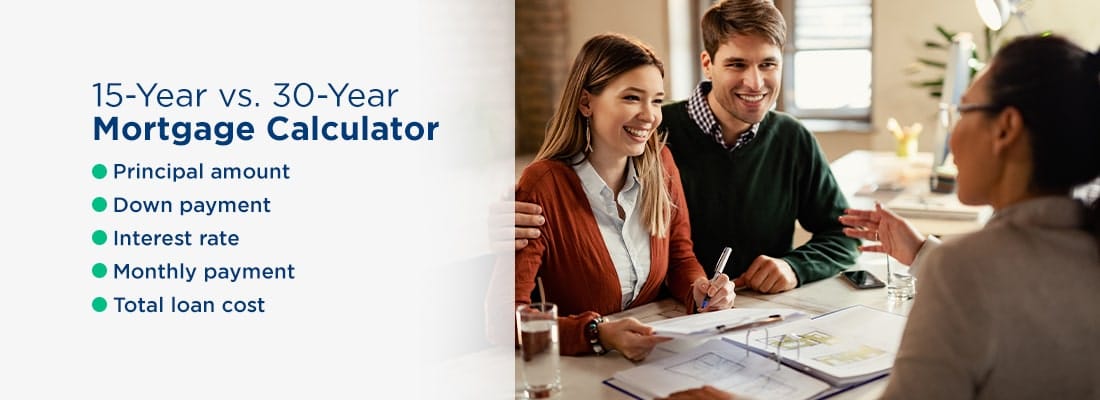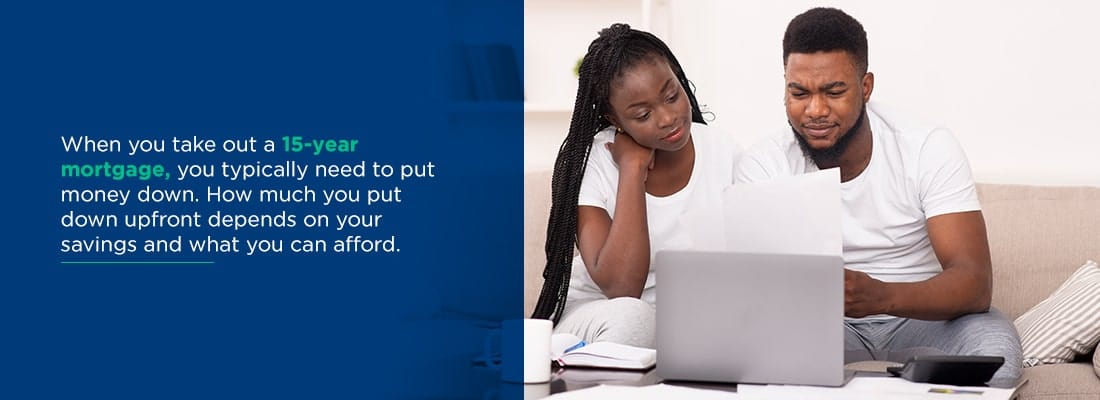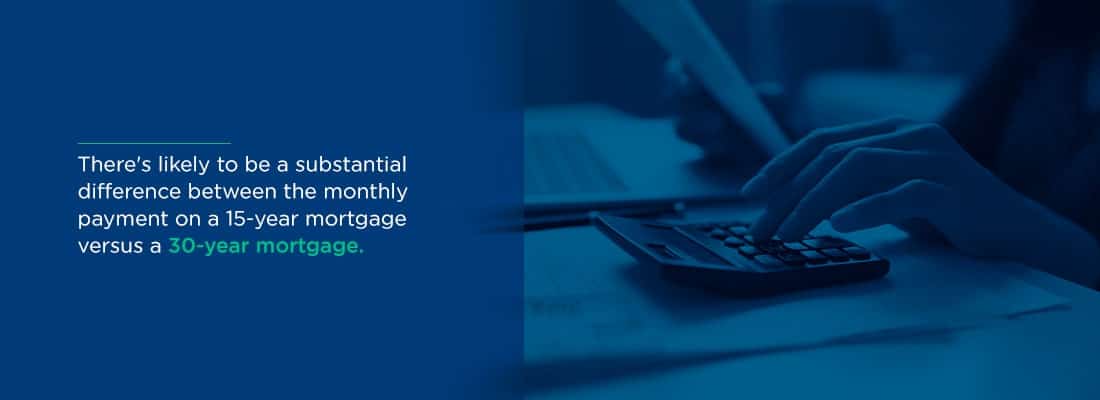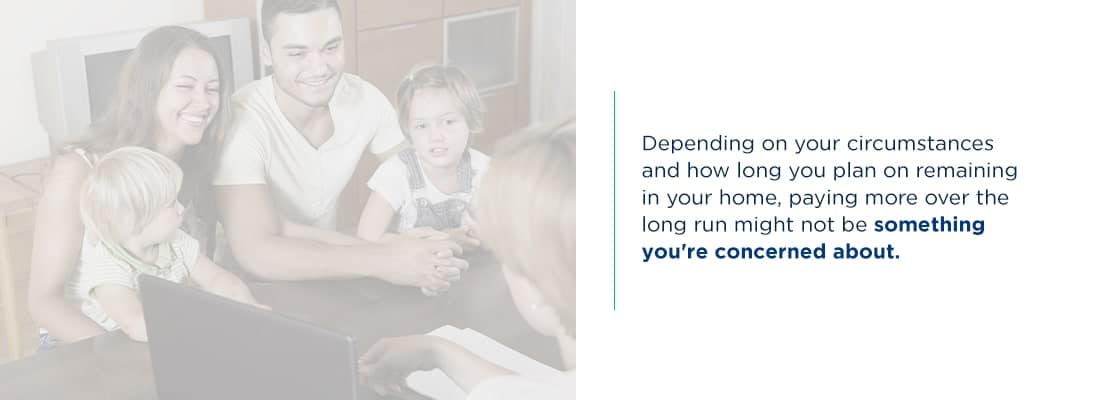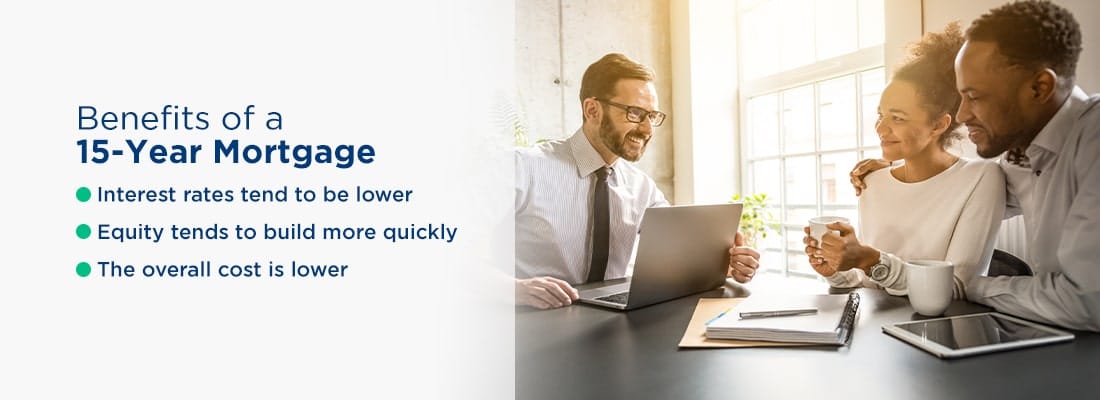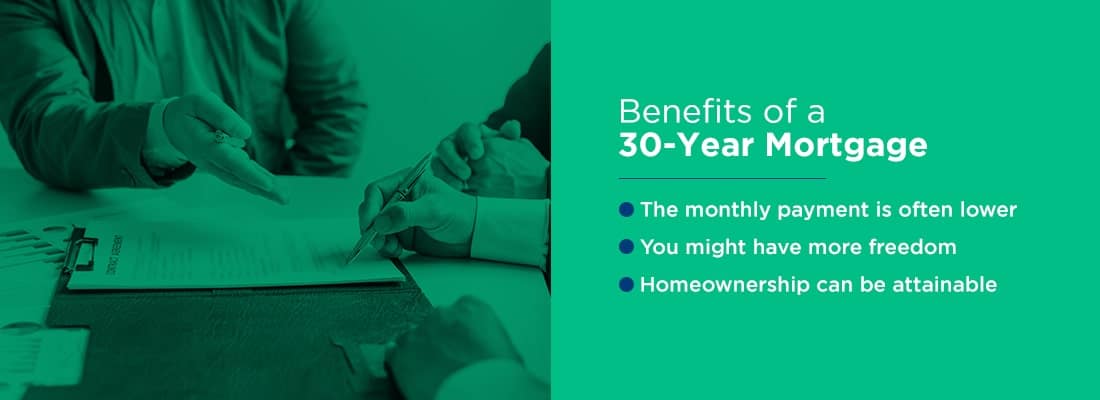When you’re shopping around for a mortgage, there are several choices you’ll make that affect the monthly payment on the loan and how much you end up paying to own your home. One decision to make is how long your mortgage will last. Options include 10, 15, 20 and 30-year mortgages. Of the various loan terms, 15-year and 30-year mortgages tend to be the most common.
Each loan term has its benefits, depending on your financial situation. Learn more about how the loan term affects the interest rate, monthly payment and other mortgage features.
Table of Contents
- 15 vs. 30-Year Mortgage Calculator
- What is a 15 Year Mortgage?
- What is a 30-Year Mortgage?
- Cost Differences
- Which is Best for You?
- Benefits of a 15-Year Mortgage
- Benefits of a 30-Year Mortgage
- Apply Today!
- Principal amount: The principal amount is how much you’re borrowing. Often, it’s not the same as the price of the home you’re buying, as you’ll most likely be making a down payment.
- Down payment: The down payment is how much you pay upfront when you close on the house and take out the home loan. It typically ranges from 3% to 20% of the home’s price, but you can put down more if you can afford to do so.
- Interest rate: The interest rate is the cost of taking out a mortgage. The more risky a loan is for a lender, the higher the rate.
- Monthly payment: The monthly payment is what you’ll need to pay for the mortgage every month. It’s usually higher for a 15-year loan since you’re paying off the principal more quickly.
- Total loan cost: The total loan cost is the amount you’ll pay for the mortgage over the next 15 or 30 years. It’s likely to be higher for a 30-year loan than for a 15-year one.
- You can afford a higher monthly payment:15-year mortgages typically have higher monthly payments since you’re paying the loan off in half of the time. Take a close look at your budget to figure out how much you can comfortably afford to spend on your mortgage each month. It could be that you can swing the higher monthly payment of a 15-year home loan based on your income and other financial commitments.
- You want to focus on saving cash: On the flip side, the lower monthly payments 30-year mortgages typically offer might make more sense for you if you want to build up cash reserves or save money for other financial goals, such as retirement or your child’s college education. You might have more disposable income or more money to dedicate toward savings if you choose a loan with a 30-year term.
- You want flexibility: You can enjoy more wiggle room with a 30-year mortgage compared to a 15-year loan, in some cases. As long as the mortgage doesn’t have a prepayment penalty, you can pay more towards it each month, pay the loan down more quickly and reduce the total costs. If your financial situation changes, you can switch back to paying only the minimum required. You can do the same with a 15-year loan, but since the monthly payments tend to be higher, paying extra might be more of a stretch for you.
- You want to get the lowest interest rate possible: If interest rates are low, you have excellent credit and you’re putting down 20% or more on the home, taking out a 15-year loan can be what helps you get the best interest rate available. Even with all other factors considered, the rates on 15-year mortgages tend to be lower than on 30-year loans. Getting the lowest rate possible lets you save money each month and in the long run.
- You want to buy a bigger or more expensive home: Depending on your housing needs or the area you live in, a 30-year mortgage might be the option that lets you become a homeowner. For example, if you live somewhere where housing prices are higher than average, you might need to take advantage of the lower payments available with a 30-year loan to afford a home. Or, if you need to buy a larger house to accommodate your family’s needs, a 30-year mortgage can make doing so affordable.
- You want to be debt-free sooner: Although mortgage debt is typically an example of good debt, you might be dreaming of the day when you’ll be entirely debt-free. In that case, a 15-year loan can help you reach your goal sooner.
- Interest rates tend to be lower: You’re likely to get a lower interest rate on a 15-year loan, which saves money in the short term and the long term. Long term, you’ll pay less interest since you are making 180 payments, rather than 360.
- Equity tends to build more quickly: Your home’s equity is the difference between the value of your home and the amount you still owe on the mortgage. With a 15-year loan, you build equity faster since you pay more towards the principal each month. Paying off the loan more quickly also lets you build equity. With more equity, you can borrow against the house to make renovations or pay for other big expenses, such as your children’s college. Having more equity also means you get to pocket more money if you eventually sell the home.
- The overall cost is lower: The total cost of a 15-year mortgage might be substantially less than a 30-year home loan. The lower interest rates combined with fewer payments means the cost of interest ends up being significantly lower. If you need to take out PMI, you might get a lower monthly premium with a 15-year loan, further reducing the mortgage cost. Plus, you might end up buying a home with a lower price tag if you choose a 15-year loan, which also reduces the total cost of the house.
- The monthly payment is often lower:The monthly payment on a 30-year loan is usually less than the monthly payment on a 15-year loan. That can mean one of two things. If you can afford the higher, 15-year loan payments, you might be able to buy a more expensive home with a 30-year loan. If the payment on a 15-year mortgage is out of your reach, choosing a loan with a 30-year term can make homeownership financially attainable.
- You might have more freedom: You can expect to have some more freedom with a 30-year loan than a 15-year mortgage. You can make adjustments to your budget more easily when your mortgage payment is lower. If you want to, you can pay extra on the mortgage each month, even potentially treating it like a 15-year loan. If you need to, you can pay only what’s required. Since a 30-year mortgage can make homeownership more affordable, you might find you have income left over each month to set aside for other financial goals. If necessary, you can build up an emergency fund, boost your retirement savings or set money aside for a vacation.
- Homeownership can be attainable: 30-year mortgages are the most popular type of home loan for a reason. They open the doors to homeownership for a wider range of people. If a 15-year mortgage were the only option, many people wouldn’t be able to afford the higher monthly cost or would be limited to buying the least expensive homes.
15-Year vs. 30-Year Mortgage Calculator
One of the quickest ways to see the difference between a 15-year and a 30-year mortgage is to use a mortgage calculator. The calculator will give you an idea of the cost of your monthly payment based on the length of the loan, the interest rate you pay and the size of the mortgage.
Some things to understand when using a mortgage calculator include:
What Is a 15-Year Mortgage?
A 15-year mortgage is a home loan with a term that lasts 15 years. When you take out a 15-year mortgage and follow the repayment schedule exactly, you’ll have paid off your home in 15 years. It’s possible to pay off the mortgage sooner by making additional payments to the principal each month or from time to time. You can also refinance the mortgage at some point to take advantage of a lower interest rate or to change the length of the loan.
A 15-year mortgage might have a fixed interest rate or an adjustable rate. A fixed interest rate will remain the same throughout the mortgage term. If it’s 5% on day one, it will be 5% on the final day. Fixed-rate mortgages offer some level of predictability. No matter what happens with the market, you can rest assured that your monthly mortgage principal and interest payment will remain the same throughout the life of the mortgage.
If you choose a 15-year mortgage with an adjustable rate, you’ll likely be offered a special introductory or “teaser” rate, which will remain the same for a set period, such as five years. Once the introductory period is up, your rate can change based on the market. If you started with a 5% interest rate, it might jump up to 7% or drop to 4%, depending on current interest rates. After the introductory period, your rate will adjust on a set schedule, such as annually or every two years.
An adjustable-rate 15-year mortgage can be the more affordable option at first, particularly if rates are very low when you apply for the loan. But as rates change, you might see your monthly payment increase substantially. It’s important to make sure you can afford the monthly payment on your 15-year home loan, whether rates are low or high, if you choose to apply for one with an adjustable rate.
When you take out a 15-year mortgage, you typically need to put money down. How much you put down upfront depends on your savings and what you can afford. In some cases, a larger down payment, such as 20%, makes sense, as it means you’ll have a smaller mortgage and less to pay each month. A 20% down payment also means you don’t have to take out private mortgage insurance (PMI).
A smaller down payment, such as 5% or 10%, can make sense when applying for a 15-year loan. Putting less down means you can buy your home sooner rather than later. A smaller down payment can also allow you to keep some cash in reserve if you need it to pay for repairs. With a smaller down payment, you’ll have to pay PMI, which does add to your monthly mortgage costs.
What Is a 30-Year Mortgage?
A 30-year mortgage lasts for 30 years, provided the loan holder pays exactly as agreed, doesn’t make any additional payments on the loan and doesn’t refinance it. As with a 15-year home loan, you can pay off a 30-year mortgage before the full term by paying extra toward the principal each month or when you can afford to do so. You might also refinance the mortgage at some point to take advantage of lower interest rates or better loan terms. A refinance might extend the mortgage term or reduce it.
Like a 15-year mortgage, you can choose a 30-year loan with a fixed interest rate or an adjustable interest rate. A fixed-rate mortgage can be ideal if interest rates are low when you take out the loan. You’re effectively “locking in” the low rate. No matter what happens over the next three decades, your rate won’t go up or down.
An adjustable rate mortgage can make sense if rates are high when you apply for the loan, and you expect them to drop eventually. After the introductory term, getting a lower rate on the loan can mean your monthly payments drop significantly. If you get an adjustable rate mortgage when rates are high, you can most likely refinance to a fixed-rate loan if rates fall in the future. That way, you can lock in a lower rate on your mortgage.
The monthly payment on a 30-year mortgage depends on the price of the home you’re buying and the size of your down payment. The bigger your down payment, the lower your principal amount and the lower your monthly payment. As with a 15-year loan, if you put down less than 20% when buying a house with a 30-year mortgage, you’ll most likely need to pay PMI premiums, usually until you’ve paid off enough of the loan so that the principal is 80% or less of the home’s value.
Many people find that taking out a 30-year mortgage allows them to buy a bigger or more expensive home than they could afford if they chose a 15-year home loan. Spreading the payments out over a longer term can help you buy a home in an area that would otherwise be financially out-of-reach. This is likely why 30-year mortgages are more common than 15-year home loans.
Costs of a 15 vs. 30-Year Loan
When trying to decide between a 15-year mortgage and a 30-year mortgage, it can be helpful to compare the costs of each option. Generally, a 30-year loan costs less upfront but costs more over time. You’ll pay more upfront for a 15-year loan but can end up saving a considerable amount in the long run. The following are areas in which you’ll experience differences between these two loan types:
1. Monthly Payments
There’s likely to be a substantial difference between the monthly payment on a 15-year mortgage versus a 30-year mortgage. Since you’re spreading out the payments on a 30-year loan over 360 months, rather than 180 months for a 15-year loan, you end up with a much smaller monthly payment.
Some borrowers take advantage of the lower monthly payments by purchasing a more expensive home. For example, with a 30-year mortgage, you might be able to afford a $300,000 home while you could only afford the payments on a $200,000 home with a 15-year mortgage.
2. Interest Rates
Several things determine the interest rate your lender offers, including the mortgage term. Generally, the less risky the lender thinks you are, the lower the interest rate they offer. Most lenders consider 15-year mortgages to be lower risk than 30-year loans, as it takes less time for the borrower to repay them, meaning there’s less chance that someone will default on the loan.
For that reason, you’re likely to get a lower rate if you apply for a 15-year loan than you would for a 30-year loan, even if everything else is the same, such as the size of the mortgage, your credit score and your down payment. A lower interest rate means your monthly payment is lower, saving you money in the short term. You’ll also put more money towards the principal on the loan more quickly when you get a lower rate.
3. PMI Premiums
If you put down less than 20% when you take out a mortgage, the lender will likely charge you PMI premiums. PMI offers the lender protection in case you default on the loan or stop making payments.
The size of your PMI premium depends on several factors, including the size of your down payment. Usually, the lower the down payment amount, the higher your premium. The size of the loan and the loan term also influence the size of your insurance premium. With a 30-year loan and a small down payment, you might expect a higher PMI premium than with a 15-year loan and a small down payment. Your premiums can be a monthly fee that is tacked on to your mortgage payment, or you can pay the full premium upfront when you close on the home.
4. Total Costs
In the long run, a 15-year mortgage often ends up costing less than a 30-year mortgage. Paying a lower interest rate every month can add up to significant savings over time. A lower PMI premium can also help you save money.
Depending on your circumstances and how long you plan on remaining in your home, paying more over the long run might not be something you’re concerned about. If you’re concerned about saving as much money as possible or paying as little as possible in extra costs for your home, a shorter mortgage term might be right for you.
Should You Choose a 15-Year or 30-Year Mortgage?
Mortgages aren’t one-size-fits-all. What works for one borrower might not be right for another. When deciding between a 15 or 30-year mortgage, here are some things to think about:
Benefits of a 15-Year Mortgage
If you’re considering a 15-year mortgage, here’s a quick review of some of the benefits of a shorter-term mortgage:
Benefits of a 30-Year Mortgage
For the right borrower, 30-year mortgages have their advantages. Some notable benefits of a 30-year home loan include:
Apply for a Mortgage With Assurance Financial Today
When choosing a mortgage, there’s more to think about than the size of the loan and the interest rate. The loan term is also worth your consideration. Whether you are leaning towards a 15-year loan or a 30-year mortgage, Assurance Financial can help you find the home loan that’s right for you. Start your mortgage application today to learn more about your options.
Linked Sources:


